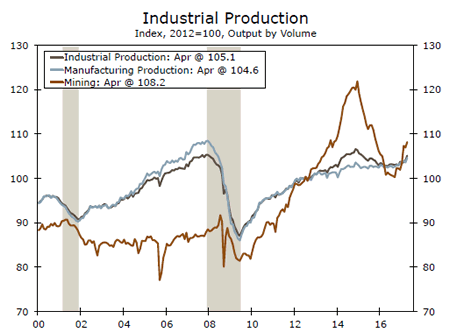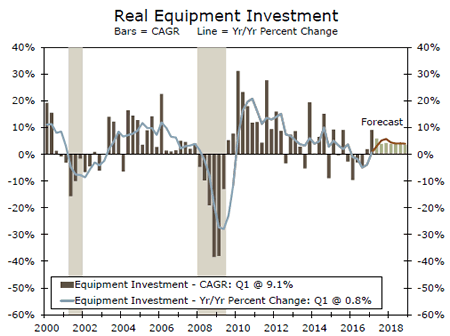U.S. Review
Economic Data Offer Mixed Signals
- Industrial production, a key barometer for the manufacturing sector, jumped 1.o percent in April, surpassing expectations for a more modest increase. The positive print for industrial production was accompanied by mixed results in the survey data, however, as the New York Empire State factory index slumped into contraction territory in May, while the Philly Fed index soared higher.
- Housing starts missed in April, declining 2.6 percent to a 1.172 million-unit annualized rate. The pullback was entirely driven by weakness in multifamily, which dwarfed a slight pickup in single-family starts. We continue to expect residential construction to be driven by growth in single-family housing.
Economic Data Offer Mixed Signals
Industrial production was arguably the most important data point of the week. This key barometer for the manufacturing sector jumped 1.o percent in April, surpassing expectations for a more modest increase. The series is now 2.2 percent above its year-ago level, which marks the strongest pace since 2014. The report details showed broad-based strength, as production rose across most household and business goods. Notably, manufacturing output climbed 1.0 percent on the month, and with that increase the overall level of manufacturing production is at a fresh cycle high (top chart).
The positive print for industrial production was accompanied by mixed results in the survey data. Post-election euphoria has largely receded from the sky-high levels registered earlier this year, with the ISM manufacturing index edging lower in recent months. The New York and Philadelphia Fed surveys, released this week, offered a first look at May manufacturing sentiment. The New York Empire State index slumped into contraction territory in May, while the Philly Fed index soared higher (middle chart). Despite the month-to-month fluctuations, in our view, the hard data are improving incrementally, and we continue to expect a gradual firming in the factory sector through our forecast horizon. For further reading on our business investment outlook, please see, Finally Making a Big Production Out of It?
Housing starts missed in April, declining 2.6 percent to a 1.172 million-unit annualized rate, disappointing consensus expectations for a modest gain. The pullback was entirely driven by continued weakness in multifamily, which dwarfed a slight pickup in single-family starts. Multifamily starts fell 9.2 percent in April, marking the sector’s fourth consecutive decline (bottom chart). Growth in multifamily construction is expected to continue to slow amid lessening demand and the onslaught of supply that has inundated the market in recent years.
The shift toward single-family homes is also supported by recent household formation data. The number of owner-occupied homes rose faster than renter-occupied housing in Q1 for the first time since 2006. With residential construction increasingly expected to be supported by growth in single-family housing, we continue to monitor the sector closely. Single-family starts inched up 0.4 percent in April, driven by gains in the Midwest and West. For the first four months of the year, single-family starts are running a healthy 7.0 percent ahead of their year-ago level. Leading indicators for single-family construction are mixed, however. Single-family permits, an indicator for future construction activity, have edged down over the past two months and are now trending below the pace of starts. In contrast, the May reading for the NAHB/Wells Fargo Housing Market Index, which measures homebuilder sentiment in the single-family market, rose to its second-highest level of the current cycle. Given housing starts weaker start to Q2 and the reported decline in housing permits, we expect residential investment to provide a smaller contribution to overall GDP in Q2 relative to the gains posted in the prior two quarters.
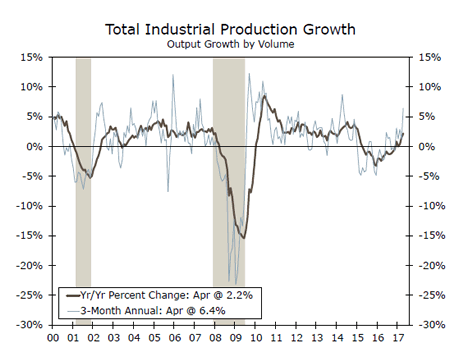
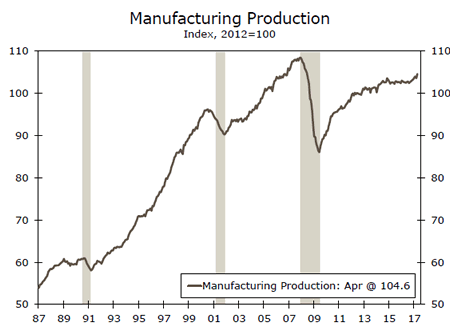
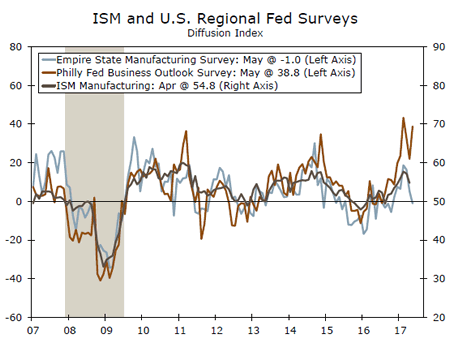
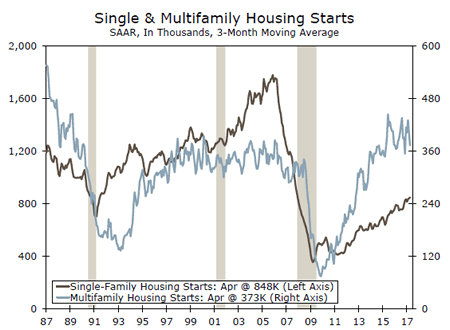
U.S. Outlook
New Home Sales • Tuesday
New home sales surprised to the upside by rising 5.8 percent in March to a 621K-unit pace—its second highest point of the current cycle. Revisions to prior months’ data added to the rosy picture of the new home buying season early in 2017. We could have had a bit of a payback from warm weather in January and February pulling forward sales from March, but that did not appear to be the case, which speaks to the strong underlying fundamentals currently supporting the new home market. The labor market is the number one support as job growth has pushed the unemployment rate to cycle-lows, putting homeownership in closer reach of more people.
Homebuilders have noted the improvement in housing demand in the NAHB/Wells Fargo Housing Market Index, which has hovered near its cycle-high in recent months. We expect new home sales increased further in April to a 622,000-unit pace, which would be a fresh cycle-high.
Previous:621,000 Wells Fargo: 622,000 Consensus:625,000
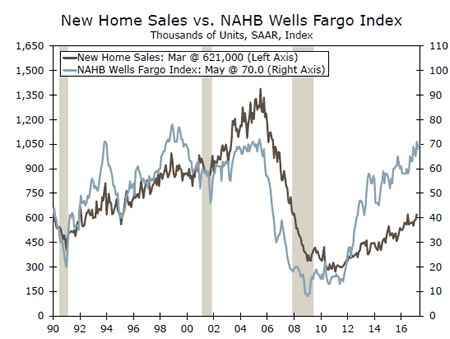
Durable Goods Orders • Friday
Growth in durable goods orders disappointed consensus in March, rising 0.9 percent as orders of motor vehicles slipped while aircraft orders surged. Boeing received 15 orders in April compared to 147 in March, increasing the likelihood that total durable goods orders slipped on a month-over-month comparison in April. Orders of nondefense capital goods excluding aircraft, our bellwether of planned business investment, appeared to be softening since the end of last year on weaker orders of computers and electronics.
The new orders index in April’s ISM survey also slipped from recent highs, suggesting either some moderation in core goods orders may in the offing for April, or that "soft" data are starting to come back in line following the post-election surge. We continue to expect hard data from the factory sector to show a gradually improving trend behind month-to-month volatility.
Previous: 0.9% Wells Fargo: -1.8% Consensus: -1.4% (Month-over-Month)

Consumer Sentiment • Friday
The University of Michigan’s Consumer Sentiment index remained elevated in April and into the first few weeks of May, with the first look coming in at 97.7 for May. In recent months, it appears that sentiment is bolstered by their positive assessment of the present situation; although the expectations index gave back some of the post-election surge. Consumers continue to note their current financial outlook has improved and are encouraged about future income gains. Notably, very few consumers complained about inflation, which helped boost expectations about future income.
The first look at May’s results noted most interviews were conducted before the firing of the FBI Director and the tumult that followed—any impact of which would be apparent in the final print. The Univ. of Michigan Consumer Sentiment report has examined the partisan divide and consumers’ economic outlook, particularly the issue of tax reform on future income.
Previous: 97.0 Consensus: 97.5

Global Review
Longest Growth Stretch in 11 Years in Japan
- Five straight quarters of growth. It may not sound like much, but as the chart at right shows, uninterrupted growth in Japan has been difficult to achieve. We break down the details in this week’s Global Review on page 4.
- Other global economic highlights featured this week include a look at inflation dynamics in the United Kingdom and Canada as well as what is driving the remarkably strong growth in Australian jobs.
Japanese GDP
The fifth straight quarterly increase in real GDP growth in Japan came from broadly based support. The largest overall positive contributor came from consumer spending, which added 0.8 percentage points to the overall growth rate. Retail sales in Japan had strung together three straight monthly increases which has lifted the yearly growth rate for store sales to the fastest pace since April 2015 (the year-over-year surge then had to do with the 2014 implementation of a consumption tax hike which suppressed spending in April 2014). Bottom line consumers in Japan are spending again at a pace not seen in years.
Consumers are not the only ones feeling a bit more confident. The Tankan survey of large manufacturers rose in the first quarter to its fastest pace of expansion since 2015 and business spending also lifted GDP growth in Q1. Admittedly, the 1.0 percent annualized pace of growth for business outlays is hardly overwhelming but it marks the third consecutive quarterly increase—the longest winning streak for cap-ex since 2014.
Despite this better-than-expect GDP report, inflation moved further away from the central bank’s target in March suggesting a continued dovish policy bias from the Bank of Japan.
Inflation in the United Kingdom
Speaking of inflation, we learned this week that CPI inflation continued to firm in the United Kingdom. In fact the year-overyear rate of CPI inflation of 2.7 percent is well-above the Bank of England’s (BoE) 2.0 percent target and represents the fastest consumer prices have climbed since 2013. To some extent the higher prices are a pass-through effect of weakened sterling. If the BoE takes that view, which we expect it will, the current above target inflation will likely be viewed as a transitory and will not compel the Monetary Policy Committee to hike rates in response.
Australian Payrolls
The Australian economy added 37,400 jobs in April. This follows the largest monthly jobs surge in two years in the prior month. Most analysts evidently thought the solid job growth in March might be tough to follow in April judging by the more modest job increase of 5,000 that was expected by the consensus.
Taken together, the two-month period culminated in the secondlargest back-to-back job pickup in Australia in the past 13 years.
CPI Inflation in Canada
After an unexpected slowing in Canadian CPI in March, consumer prices picked up in April, but not as much as expected. The monthly increase of 0.4 percent kept the year-over-year rate of CPI inflation unchanged at 1.6 percent. We do not expect the latest inflation figure to substantively influence Bank of Canada (BoC) policy in the near term. In fact, the inflation story is more or less living up to the Bank’s expectations. Following its April 12 meeting, the BoC said that "CPI inflation is expected to dip in the months ahead, as the temporary factors unwind, and then return to 2 per cent later in the projection horizon as the output gap closes."
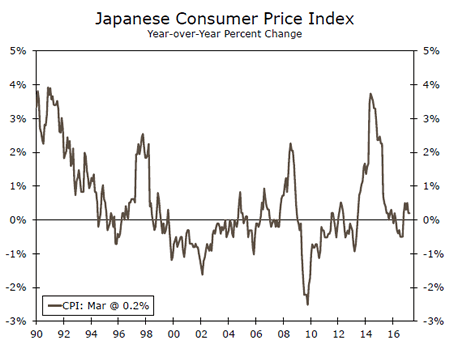

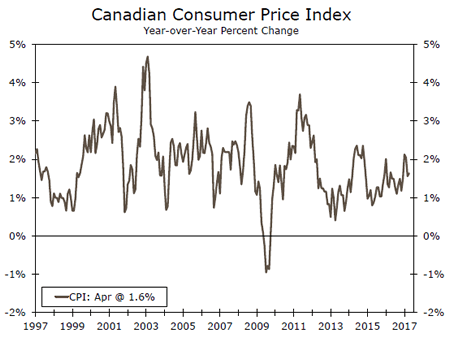
Global Outlook
Mexico Q1 GDP • Monday
Mexico is slated to release the final print for Q1 GDP on Monday. While the flash release told a relatively good story regarding the performance of the Mexican economy during the first quarter of the year, we believe that Monday’s release, which includes the demand side GDP, will be enlightening, especially regarding gross fixed investment, exports of goods and services, and personal consumption expenditures. Still, the data will be very noisy just because the Easter holiday occurred during the first quarter in 2016, while it occurred during the second quarter this year. This makes the comparisons tricky even if the INEGI, the Mexican statistical institute, tries to correct for seasonality as well as for calendar days in their data release.
Having said this, the Mexican economy surprised on the upside in the first quarter and having more details will help markets make better decisions.
Previous: 2.7% (Year-over-Year) Wells Fargo: 2.7% Consensus: 2.7%

German Ifo • Tuesday
The same day we get the German manufacturing PMI, we will be able to take a look at German business confidence numbers for May with the release of the Ifo business climate, expectations and current assessment indices. The business climate index has been improving since early this year, while the expectations index slowed down a bit in April after increasing during the first quarter of the year. Meanwhile, the current assessment index has been improving since August of last year. Consensus is expecting an improvement in both the business climate and expectations numbers, while a lower reading for the current assessment component of the index.
We will also get the GfK consumer confidence index for the month of June. This index has been hovering at 10 for more than a year but it hit a high of 10.2 in May, and consensus is expecting the index to remain at that level in June.
Previous: 112.9 Consensus: 113.1

Eurozone Manufacturing PMI • Tuesday
The manufacturing industry across the world has been recovering from a very weak performance during the past several years. On Tuesday, markets will be able to gauge if the recent improvement in manufacturing remains in place with the release of the Eurozone and German manufacturing PMIs.
The Eurozone’s manufacturing PMI was at a high of 56.7 in April with consensus expecting that number to come down a bit, to 56.5 in May. The Eurozone manufacturing PMI has been slowly improving since August of last year. Meanwhile, consensus has the German May’s manufacturing PMI at 58, slightly below the 58.2 reading in April. If consensus is correct, this will be the second consecutive weakening in this index this year.
Previous: 56.7 (Manufacturing) Consensus: 56.5
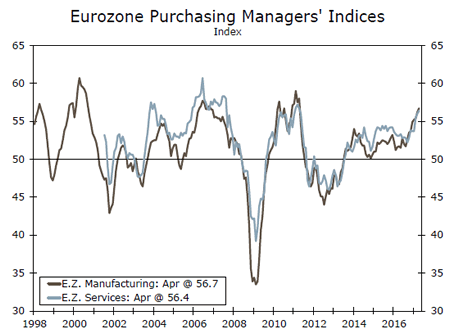
Point of View
Interest Rate Watch
Late Cycle Policy and Credit
Economic policy actions and their effectiveness must be judged by the state of the economic and credit cycle. Right now, the state of these cycles indicates to us the projections of monetary policy actions are too strong relative to the strength of the cycles.
Profit Challenge: Past the Peak
As illustrated in the top graph, profit margins for nonfinancial corporate companies are beyond the mid-cycle peak. Consistent with traditional economic cycle patterns, the employment cost index is expected to rise significantly in 2017 compared to both 2015 and 2016. With tighter profit margins, many firms did increase earnings in the fourth quarter, but primarily by cutting costs and not raising revenues.
Now enters the Fed with the intention to raise the funds rate at least twice more this year and three or more moves in 2018. Moreover, the Fed is also considering shrinking its balance sheet at the end of 2017 and through 2018 and thereby adding upward pressure to the middle and longer ends of the yield curve.
Weaker Credit Performance on C&I Loans
Noncurrent loan rates have risen in Q4 of 2016 over the same period a year ago as illustrated in the middle graph. Higher rates are across all industries and not just a result of the weakness in the energy sector over the past two years. Further interest rate increases are likely to increase pressure on business borrowing as the latest Fed Senior Loan Officer Opinion Survey already indicates that large and small businesses’ demand for loans has been moderating since the start of 2016. Domestic and foreign banks reported weaker loan demand on net over the first quarter.
Tighter Auto Market
As illustrated in the bottom graph, the auto market is showing strains from both tighter credit standards and weaker demand. Add on declines in both new and auto prices, pressures exist to limit the Fed’s ability to raise rates ahead.

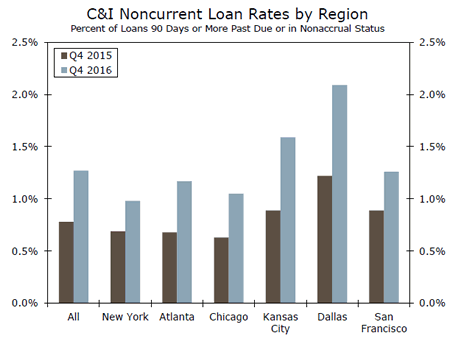

Credit Market Insights
Loan Demand Cools in Q1
The Federal Reserve’s April 2017 Senior Loan Officer Opinion Survey (SLOOS), pointed to a general slowdown in loan demand for businesses and consumers.
On the commercial and industrial front, domestic and foreign banks reported weak loan demand on net over the first quarter. Notably, the slowdown in C&I lending does not appear to be due to stricter lending standards, as banks reported no significant net tightening. Business investment was particularly strong in Q1, suggesting firms turned to other sources of funding to fuel their capital spending.
The Fed survey also showed a cooling in consumer loan demand, a finding consistent with the weak pace of consumer spending in Q1. Lenders reported reduced demand for most consumer loan categories over the quarter, with particular softness in demand for credit card and auto loans. Auto lending standards tightened for the fourth consecutive quarter, reflecting the continued slowdown in the auto sector.
Finally, a significant net share of banks reported further tightening in most CRE loans. The uncertain outlook for CRE property prices, vacancy rates and reduced risk tolerances all contributed to the more cautious approach by banks.
On balance, faster economic growth should help spur growth in loan demand, but the cautious approach by banks and businesses suggest economic growth is more likely to be moderate than robust in the quarters ahead.
Topic of the Week
Soft Data Softening
The current economic expansion, which began in the summer of 2009, is approaching its eight-year anniversary. Yet, industrial production (IP) is not currently above its pre-recession peak. This is somewhat perplexing as IP is a primary factor in business cycle dating. Broadly, IP surged due to increased activity in the energy sector, and then tapered in growth as commodity prices fell. At this mature point in the business cycle, a rebound is unlikely in our view.
Purchasing manager surveys and measures of consumer and business confidence have hit multi-year highs in 2017. However, the hard data do not necessarily support this heightened optimism. While the hard data, such as IP and factory orders, do support steady growth, April’s ISM manufacturing print of 54.8 marked the third consecutive monthly decline and fell short of consensus expectations. After months of disparity between lackluster hard data and multi-year highs in soft data, there is a convergence underway. In our view, the weaker readings of soft data should not cause fear, as both the hard and soft data still supports growth at a modest pace.
Though fleeting, there are occasional glimmers of hope that the hard data could be moving higher. Revisions to hard data in recent months, such as orders and shipments, supports a solid 9.4 percent annualized pace of business fixed investment spending growth. Moreover, while IP has yet to reach pre-recession highs, April’s reading of IP showed the largest monthly increase in three years of 1.0 percent, while factory sector production climbed to its highest level of the current expansion. Should a substantive corporate tax cut come to fruition, we would expect to see strengthening in both hard and soft production data points—however, the inability to pass any major legislation in the first 100 days causes skepticism of the size and scope of any legislation aimed at boosting business investment.
On trend, the hard data are firming incrementally and the sugar high is wearing off for business sentiment. What remains is a forecast that is anything but flashy: slow steady growth in the manufacturing sector and gradual firming for industrial production.
